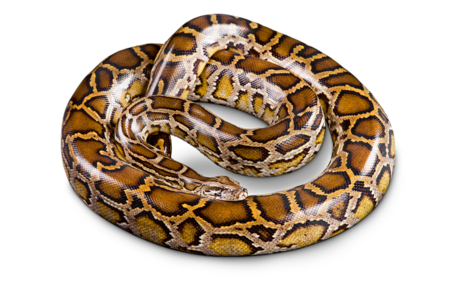Burmese Python
Python bivittatus
![[Translate to English:] [Translate to English:] Eine dunkle Tigerpython.](/fileadmin/_processed_/7/b/csm_dunkler-tigerpython-tierpark-hellabrunn-reptilien-tierlexikon_4c680d91f0.jpg)
- FamilyPythons (Pythonidae)
- Length5 – 7 m
- HabitatTropical rainforests, river valleys, forests, grass- and bushlands
Patient hunter
Pythons can detect prey with their exceptionally fine sense of smell and heat pits along the upper lip. The heat pits are used to perceive infrared radiation such as the body heat of a prey. Once a victim (rat, deer, etc.) located, it will wrap its body around it, contracting its muscles until the animal strangles. It often lurks underwater, patiently waiting for prey to approach.

Luxury leather
The Burmese python is characterised by the arrow-shaped marking on top of the head and brown blotch pattern outlined in yellow. This skin pattern makes the leather highly sought-after. Although the Burmese python is a protected species, it is still under threat from rampant poaching – the meat and eggs are also in demand as a delicacy in Asia and other distribution areas. Large specimens are not suitable as pets as they present a danger to owners.
Burmese pythons do not bury their eggs, but incubate them by coiling around the eggs and twitching their muscles to generate frictional heat.
Distribution
